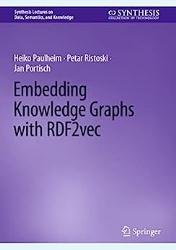 Название: Embedding Knowledge Graphs with RDF2vec
Название: Embedding Knowledge Graphs with RDF2vecАвтор: Heiko Paulheim, Petar Ristoski, Jan Portisch
Издательство: Springer
Год: 2023
Страниц: 165
Язык: английский
Формат: pdf (true), epub
Размер: 19.6 MB
This book explains the ideas behind one of the most well-known methods for knowledge graph embedding of transformations to compute vector representations from a graph, known as RDF2vec. The authors describe its usage in practice, from reusing pre-trained knowledge graph embeddings to training tailored vectors for a knowledge graph at hand. They also demonstrate different extensions of RDF2vec and how they affect not only the downstream performance, but also the expressivity of the resulting vector representation, and analyze the resulting vector spaces and the semantic properties they encode.
Knowledge graph embedding is a technique which projects entities and relations in a knowledge graph into a continuous vector space. Many other components of AI systems, especially machine learning components, can work with those continuous representations better than operating on the graph itself, and often yield superior result quality compared to those trying to extract non-continuous features from a graph.
Moreover, the authors would like to thank the developers of pyRDF2vec and the Python KG extension, which we used for examples in this book, especially Gilles Vandewielle for quick responses on all issues around pyRDF2vec, and GEval, which has been used countless times in evaluations.
When using knowledge graphs in the context of intelligent applications, they are often combined with some Machine Learning or data mining based processing. The corresponding algorithms, however, mostly expect tabular or propositional data as input, not graphs, hence, information from the graphs is often transformed into a propositional form first, a process called propositionalization or feature extraction.
Contents:
Скачать Embedding Knowledge Graphs with RDF2vec
